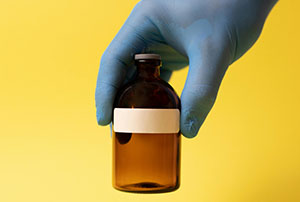
Ensuring medication safety in households with children is crucial to prevent accidental ingestion and potential poisoning. Proper storage and handling of medications protect children from the serious health risks associated with unauthorized access. In this post, we’ll talk about ways on how to keep prescription medication out of reach of children.
Risks Associated with Children Accessing Prescription Medication
Children may mistake medications for candy due to their appearance, leading to accidental ingestion, which can result in severe health issues or fatalities. The natural curiosity of children makes it imperative to store medications securely to prevent dangerous situations.
The need for implementing preventative measures is important. These include using locked storage, proper labeling and packaging, educating family members and caregivers, regular monitoring and disposal of medications, and teaching children about medication safety. Implementing these measures can significantly reduce the risk of accidental ingestion by children.
Special Considerations for Opioids
Opioids require extra precautions due to their high potency and risk of addiction and overdose, which have contributed to the opioid crisis. Locking medication bags, secure cabinets, and stringent monitoring are essential to ensure these medications are kept out of reach of children and prevent misuse.
Safe Storage of Medications
Use of Locked Cabinets or Boxes
Locked cabinets or boxes are essential for safely storing medications, ensuring they are out of reach of children and reducing the risk of accidental ingestion. These storage solutions should be placed in secure, inaccessible locations to enhance safety.
- Types of Locks and Cabinets: Options include combination locks, key locks, and digital locks, with cabinets made from durable, tamper-proof materials providing the best protection.
- Recommended Storage Locations: Ideal locations for storing locked cabinets include high shelves in closets or bedrooms, away from common areas where children might have easy access.
Use of Prescription Medication Bags with a Lock

Locking medication bags are portable solutions that provide secure storage for medications when traveling or needing to transport them outside the home. These bags should always be kept locked and stored in places inaccessible to children.
- Types of Locking Medication Bags: Various designs and sizes are available, equipped with combination or key locks to ensure security.
- Proper Usage and Storage: Ensure the bag is always locked after use and stored in a high, secure location when not in use.
Store Prescription Medication in High and Out-of-Reach Places
Storing medications in high and out-of-reach places is a fundamental strategy to prevent children from accessing them, thereby reducing the risk of accidental ingestion. Medications should be placed in areas that are difficult for children to reach or see, ensuring an added layer of protection.
Shelves and Cupboards
Using high shelves and cupboards for medication storage is essential. These storage areas should be at least five to six feet off the ground, ensuring they are well above a child’s reach, even if they attempt to climb. Ideally, these shelves and cupboards should be located in rooms that children do not frequent, such as adult bedrooms or closets. For added security, consider using shelves and cupboards with lockable doors. This ensures that even if children manage to reach these areas, they still cannot access the medications without a key or combination. Within these cupboards, it’s beneficial to keep medications organized in labeled bins or containers to avoid confusion and accidental misuse. While these storage areas should be out of reach for children, they should still be accessible to adults when needed, ensuring easy access without having to move or rearrange furniture.
Avoiding Common Areas
Common areas such as kitchens and bathrooms are high-traffic zones where children spend a significant amount of time. Storing medications in these areas poses a significant risk as children can easily see and reach them. In kitchens, medications should not be stored in cabinets or on countertops where they are visible and accessible. Instead, use higher shelves or locked cabinets located away from the main kitchen area. Bathrooms, often seen as convenient places for medication storage, are also high-risk due to the accessibility and visibility of medications. Moreover, humidity and temperature fluctuations in bathrooms can affect the efficacy of some medications. It’s better to store medications in a high, locked cabinet in a different room, such as an adult bedroom or a home office. These areas are typically off-limits to children and can serve as secure locations for medication storage. Another effective strategy is to develop consistent habits of returning medications to their designated high and secure locations immediately after use, minimizing the risk of leaving medications within a child’s reach inadvertently.
Proper Labeling and Packaging
Keeping Medications in Original Containers

Keeping medications in their original containers ensures that they are properly labeled and reduces the risk of confusion or misuse. Original containers provide vital information such as dosage instructions, expiration dates, and warnings.
- Importance of Original Labels: Original labels provide essential information that can prevent misuse and ensure proper medication administration.
- Avoiding Transfer to Non-Childproof Containers: Transferring medications to non-childproof containers increases the risk of accidental ingestion and should be avoided.
Use of Child-Resistant Packaging
Child-resistant packaging is designed to make it difficult for children to open, providing an additional layer of protection. This packaging helps prevent children from accessing medications and reduces the risk of accidental ingestion.
- Types of Child-Resistant Caps: Various child-resistant caps, such as push-and-turn and squeeze-and-turn caps, provide added security.
- Ensuring Caps are Properly Secured After Each Use: Always ensure that child-resistant caps are securely fastened after each use to maintain their effectiveness.
Educating Family Members and Caregivers
Communication with Adults in the Household

It is essential to communicate with all adults in the household about medication safety practices to ensure everyone is vigilant and informed. Clear instructions on proper handling and storage of medications can prevent accidental access by children.
- Importance of Vigilance: Emphasize the importance of vigilance in keeping medications out of reach of children.
- Clear Instructions on Medication Safety: Provide detailed instructions on how to handle and store medications safely.
Informing Babysitters, Grandparents, and Other Caregivers
Ensure that anyone responsible for your children, such as babysitters and grandparents, is aware of medication safety practices. Providing guidelines and checklists can help caregivers understand and follow the necessary precautions.
- Providing Guidelines and Checklists: Offer written guidelines and checklists to caregivers to ensure they understand the precautions.
- Ensuring Understanding and Compliance: Confirm that caregivers comprehend and adhere to these guidelines to maintain medication safety.
Teaching Children About Medication Safety
Age-Appropriate Education
Educate children about the dangers of medications in an age-appropriate manner to help them understand the risks and avoid accidental ingestion. Clear communication about medication safety can prevent children from mistaking medications for candy.
- Explaining the Dangers of Medication: Explain that medications are not candy and can be harmful if taken without supervision.
- Reinforcing the Message of Not Touching Unknown Substances: Consistently reinforce the importance of not touching or ingesting unknown substances.
Modeling Responsible Behavior
Demonstrate responsible medication practices to set a good example for children. Showing children how to handle and store medications safely can reinforce the importance of these practices.
- Demonstrating Safe Medication Practices: Show children that medications should only be taken when necessary and as directed by a doctor.
- Encouraging Questions and Discussions About Safety: Encourage children to ask questions about medication safety and provide clear, honest answers.
Knowing What to Do in Case of Accidental Ingestion
Be prepared to act quickly in the event of an emergency involving accidental ingestion of medication. Knowing the appropriate steps to take can prevent serious health consequences.
- Keep Emergency Numbers Accessible: Have the poison control number readily available and call immediately if accidental ingestion occurs.
- Seeking Immediate Medical Attention: Seek immediate medical attention if a child ingests medication, even if they appear fine.
Keeping Prescription Medication Out of Reach of
How to keep prescription medication out of reach of children is a critical responsibility for any household with young members. By prioritizing medication safety, you can protect children from the serious risks associated with accidental ingestion. Implementing secure storage practices such as using locked cabinets, high shelves, and prescription medication bags with locks, significantly reduces these dangers. Proper labeling, child-resistant packaging, and regular inventory checks further enhance safety, while educating family members and caregivers ensures everyone is vigilant and informed. Teaching children about the dangers of medications and preparing for emergencies add crucial layers of protection. Special attention to opioids, given their high risk and role in the opioid crisis, is particularly important. Through these comprehensive measures, you can effectively prevent medication-related accidents and create a safer environment for your children.
